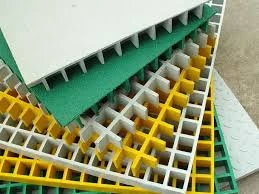loading...
- No. 9, Xingyuan South Street, Dongwaihuan Road, Zaoqiang County, Hengshui, Hebei, China
- admin@zjcomposites.com
- +86 15097380338
- Welcome to visit our website!
frp louvers for cooling tower
The Role of FRP Louvers in Cooling Towers
Cooling towers are essential components in various industrial and commercial processes, providing a crucial function in heat dissipation. When it comes to enhancing the efficiency and effectiveness of cooling towers, the design and materials used in louvers play a significant role. Fiber Reinforced Plastic (FRP) louvers have emerged as a preferred choice due to their unique properties and advantages.
Understanding FRP Louvers
FRP, or Fiber Reinforced Plastic, is a composite material made from a polymer matrix reinforced with fibers. The fibers can be made from various materials such as glass, carbon, or aramid, with glass fiber being the most common in cooling applications. This combination results in a lightweight yet remarkably strong and durable material, ideal for the harsh environments often encountered in cooling towers.
Advantages of FRP Louvers
1. Corrosion Resistance One of the primary benefits of FRP louvers is their exceptional resistance to corrosion. Traditional materials such as metal can suffer from rust and degradation when exposed to moisture, chemicals, and other environmental factors prevalent in cooling tower operations. FRP, on the other hand, does not corrode, providing a longer lifespan and requiring less frequent replacements.
2. Lightweight and Durable FRP is significantly lighter than metal alternatives, which can ease the installation process and reduce structural load on the cooling tower framework. Despite their lightweight nature, FRP louvers are incredibly strong, able to withstand high winds and other environmental stresses without deforming or breaking.
frp louvers for cooling tower

3. Energy Efficiency Properly designed louvers can enhance the efficiency of a cooling tower by optimizing airflow. FRP louvers can be engineered to improve the aerodynamic performance, which facilitates better cooling potential. As a result, this can translate to lower energy consumption and increased operational efficiency.
4. Customization and Versatility FRP can be molded into various shapes and sizes, allowing for tailored solutions based on specific cooling tower requirements. Whether it is a need for a particular size or a unique architectural design, FRP louvers can be customized to meet those demands while ensuring optimal performance.
5. Easy Maintenance The smooth surface of FRP louvers makes them relatively easy to clean and maintain. Regular maintenance is essential in cooling towers to ensure effective thermal performance. With FRP, the maintenance requirements are minimized due to its inherent resistance to biological growth, such as algae and mold, which can impede airflow and cooling efficiency.
Installation and Performance
When installing FRP louvers in cooling towers, careful consideration should be given to the design and positioning to maximize airflow and cooling performance. It is essential to ensure that louvers are strategically placed to efficiently guide airflow while minimizing water splash and ensuring that the cooling media can operate optimally.
Conclusion
In summary, FRP louvers represent an innovative solution for cooling tower applications, combining durability, lightweight properties, and resistance to corrosion and biological growth. Their ability to enhance energy efficiency while being customizable for specific designs makes them an attractive option for businesses seeking reliable and effective cooling solutions. As industries continue to adapt to the demands of energy efficiency and sustainability, FRP louvers will likely play an increasingly vital role in the future of cooling tower technology.
-
The Rise of FRP Profiles: Strong, Lightweight, and Built to LastNewsJul.14,2025
-
SMC Panel Tanks: A Modern Water Storage Solution for All EnvironmentsNewsJul.14,2025
-
GRP Grating: A Modern Solution for Safe and Durable Access SystemsNewsJul.14,2025
-
Galvanized Steel Water Tanks: Durable, Reliable, and Ready for UseNewsJul.14,2025
-
FRP Mini Mesh Grating: The Safer, Smarter Flooring SolutionNewsJul.14,2025
-
Exploring FRP Vessels: Durable Solutions for Modern Fluid HandlingNewsJul.14,2025
-
GRP Structures: The Future of Lightweight, High-Performance EngineeringNewsJun.20,2025
